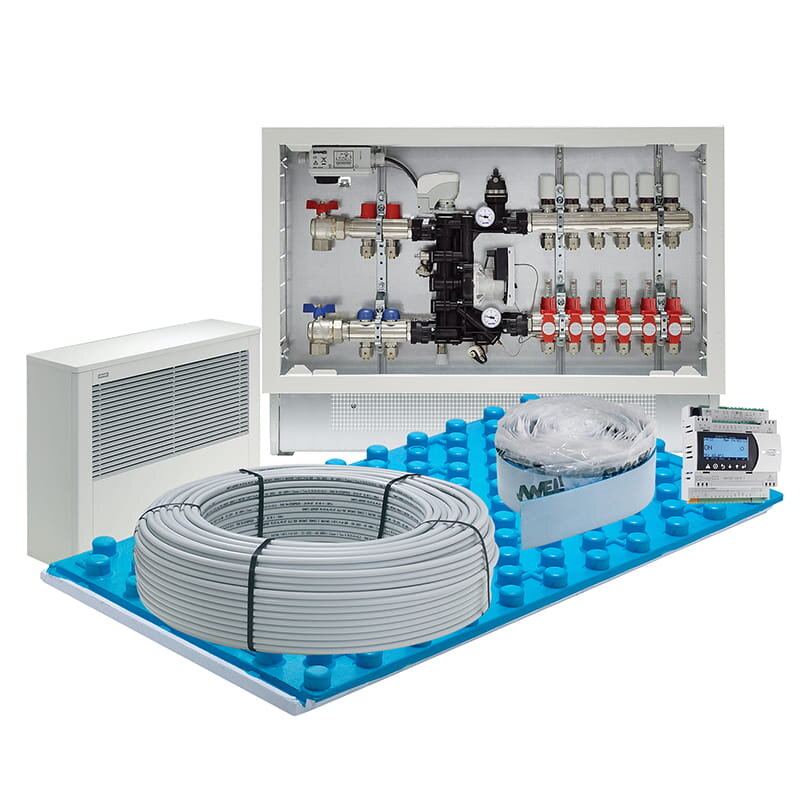Emmeti Floor:
underfloor heating and cooling systems
The most effective and pleasant heating and cooling system is underfloor heating and cooling. Underfloor heating and cooling systems are the most extensively utilized nowadays, thanks to increased building insulation and the necessity for a system that works flawlessly with low-temperature water provided by inverter heat pumps and condensing boilers.
The heat is distributed evenly throughout the various locations, and there are no convective air circulation since the heat is conveyed via radiation.

What are the benefits of underfloor heating?
Underfloor heating systems allow you to optimize all the spaces in your home by using a large surface to heat the room. To operate this system, you only need a floor temperature of 25-29°C, obtained by circulating water at 35-40°C (compared to the standard 60-70°C of radiator systems).
Under these conditions, heat loss is significantly reduced, and the heat pumps or condensing boilers can be used better, cutting consumption considerably.
In an underfloor heating system, the heat is mainly based on irradiation, creating optimal comfort. In addition, there will no longer be hot and cold areas because the heat will be evenly distributed throughout the room, from the floor to the ceiling.
How does underfloor cooling system work and what are the benefits?
Rooms can be cooled by circulating cooled water in the pipes and using the floor as a cold radiant surface. Firstly the water temperature must be checked and, therefore, the floor (generally between 20 and 22°) and the humidity present, using specific control panels which control the specially installed dehumidifiers.
If the underfloor system is correctly designed, it can be heated and cooled, guaranteeing comfort all year round.
What is the difference between the two perimeter insulations strips for UFH available in the catalogue?
The perimeter insulation strip for UFH with a size of 7x150 is for residential applications, where the concrete layer thickness is 4.5 cm on top of the pipe.
The 10x250 one is for industrial applications, where the concrete layer thickness is up to 12 cm above the pipe. It is important to use the industrial perimeter insulation strip only in industrial applications, considering that it is fully adhesive and can damage the walls.
Can the electronic regulation/control kit be used for underfloor heating and cooling systems?
Electronic regulation and control are developed to control underfloor heating and cooling systems. In the cooling installations, they have to be installed together with the humidity sensor to monitor humidity levels and activate dehumidifiers when necessary.
After installing the floor covering (ceramic tile, parquet, etc.), there are still a few inches of perimeter insulation left over the covering. What can I do?
It is normal and proper to hide the perimeter insulation with the baseboard. However, the perimeter insulation needs to be cut at the same level as the covering.
It is important to be careful when removing the insulation from the wall, as the adhesive is solid and can damage the wall.
Is it normal for the heat pump to constantly operate in an underfloor heating system?
This is quite normal because inverter heat pumps, such as Mirai SMI by Emmeti, operate by producing/consuming very little energy, and prevent inefficiency by switching on and off. This is the ideal operating condition for an underfloor system.
Is an underfloor heating system moving more dust than usual?
In an underfloor heating system, the maximum temperature of the floor surface is 29 °C (central zone), so it is not high enough to create convective air circulation, which could move the dust.
Is it true that underfloor cooling causes unpleasant odors?
The cooling system must be combined with electronic control units and dehumidifiers that control humidity, avoiding the formation of condensation and, therefore, the formation of mold and odors, while ensuring comfort and reducing consumption.
How can the expansion joints that have to be made on the concrete of a UFH system be hidden?
In general, you can make the joints correspond to the junction between the tiles. Anyway, it is possible to use silicon-based glue (to be approved for UFH by the producer) to absorb the expansion of the concrete even if the tiles cover the joint.




